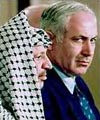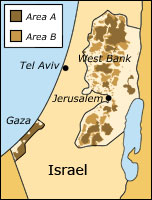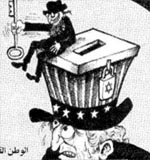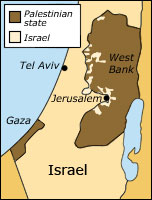|
Untitled Document
|
The
History
of Israel
- A Chronological Presentation

4.
Peace With The Arabs? (1997 - 2000)
1997-1999
- Hebron, Wye River and Sharm el-Sheikh
In August 1996 the peace negotiations were resumed,
if at a somewhat lower pace. On January 15, 1997 Netanyahu
and Arafat signed the "Hebron Agreement"
about Israeli withdrawal from most of Hebron, the
last major Palestinian city under Israeli control.
 |
 |
Arafat
and Netanya-
hu, Wye River, 1998. |
During 1997 Palestinian suicide bombing attacks,
mainly committed by Hamas, claimed the lives of 44
Israeli civilians, while wounding some 400. But after
a period of relative calm, Netanyahu and Arafat in
October 1998 met under the auspices of US president
Bill Clinton in order to negotiate the implementation
of the Oslo II Agreement from 1995. They signed the
so-called "Wye River Memorandum," which
once again stressed the Palestinian obligations regarding
security and prevention of terror. That autumn Hamas
and Islamic Jihad conducted a string of terror attacks
that claimed few deaths, while wounding nearly a hundred.
Still Israel initiated the first of three land handovers
described in the Wye agreement, after which the process
again ground to a halt.
 |
 |
Areas
transferred to Palesti-
nian control
according
to
the
Wye River agreement. |
In May 1999 Ehud Barak and the Labor Party came to
power in Israel, and in September the same year Barak
and Arafat signed yet another agreement, the "Sharm
el-Sheikh Memorandum," the main theme once again
being the Palestinians' noncompliance with their security
obligations, and the consequent Israeli delays of
planned troop withdrawals.
In the spring of 2000 Israel carried out some additional
withdrawals, leaving 18% of the total area of the
West Bank under the control of the Palestinian Authority
(Area A), while 21% was under joint control (Area
B). Even though the agreements were still not fully
implemented, more than 95% of the Palestinian population
in Gaza and the West Bank now lived under the administration
of the Palestinian Authority.
 |
 |
Israeli
soldiers rejoicing, as they
cross the border from Lebanon,
March 2000.
|
2000 - Israel Leaves
Lebanon
Ehud Barak's election promise of 1999 to bring back
all the troops from the Israeli security zone in southern
Lebanon was fulfilled on March 24, 2000, when the last
tank under cover of darkness rolled across the internationally
recognized border into Israel. The United Nations subsequently
declared the withdrawal complete.
2000 - The Oslo
Process in Difficulty
The Israeli withdrawals according to the Oslo agreements
were never fully implemented. The reason was not only
the Palestinians' lack of will or ability to prevent
terror against Israeli civilians. On a number of additional
points Arafat and the Palestinian Authority failed to
honor their obligations.
Generally, the Oslo agreements called for the establishment
of a democratic Palestinian society, and there were
specific provisions demanding the introduction of
a Palestinian legal system, operating independently
of the political leadership. In reality, Arafat had
created yet another Arab dictatorship, in which ordinary
Palestinians had no basic democratic rights. The police
force of the Authority, which, according to the agreements,
were to be limited to 24.000, totaled at the end of
the decade around twice that number. Moreover, the
many different military factions, rather than being
under the control of the Interior Ministry, to a large
extend answered directly to Yasser Arafat.
 |
 |
|
The
Jew, portrayed in classi-
cal anti-Semitic style, holds
the key to the US coffers,
Palestinian
newspaper, March
2000.
|
The Oslo II Agreement from 1995 also included a clause,
which obligated the parties to contribute, through
educational institutions and media, to the peace between
the two peoples, and to fight the spread of propaganda
against the other party. While Israel complied fully
with this requirement, the Palestinian Authority continued,
through its educational and religious institutions
as well as the media, which were under Arafat's control,
to promote an endless stream of anti-Israel propaganda.
The demanded removal of the passages in the PLO charter,
which denied Israel's right to exist and called for
the destruction of Israel, was also never carried out.
On the other hand, the Palestinians claimed that the
ongoing expansions of the Jewish settlements on the
West Bank, not only sent a less than constructive message
vis-a-vis the peace process, but were also inconsistent
with the signed agreements. The latter claim was made
with reference to a stipulation, which prohibited the
parties from taking actions that could change the status
of the territories before reaching a final peace deal.
Conversely, Israel pointed out that there nowhere in
the agreements were any limitations regarding the settlements,
the issue of which were explicitly deferred to the upcoming
final status negotiations.
2000 - Camp David,
Breakdown of the Peace Process
In the Sharm el-Sheikh Memorandum of 1999,
the date of September 13, 2000 was set as the deadline
for a final peace agreement, and as this date drew
nearer, the pressure on the political leaders to find
a solution intensified. Arafat even threatened to
unilaterally declare a Palestinian state, if no results
emerged at the negotiating table.
 |
 |
Barak, Clinton and Arafat at Camp
David, July 2000.
|
In the months of March-May 2000, four suicide bombings
claimed the lives of 8 Israelis and wounded more than
170. Still, the hope for a peaceful solution with
the Palestinians was at its highest, when Ehud Barak
and Yasser Arafat in July headed off to Bill Clinton's
summer residence, Camp David, in order to participate
in negotiations about a final peace deal.
After a few weeks of intense negotiations behind
closed doors Clinton achieved Barak's acceptance of
a proposal, according to which, a Palestinian state
would encompass all of Gaza plus some 92% of the West
Bank, with East Jerusalem as its capital and Palestinian
control over parts of the Old City, including the
Temple Mount (where Muslim religious buildings are
situated atop the ruins of the ancient Jewish temple).
 |
 |
Bill
Clinton's vision for a Pale-
stinian state in Gaza and most
of the West Bank (additional
land swaps not shown).
|
In addition it was suggested that the Palestinians,
as compensation for the inclusion of the largest settlement
blocks into Israel, would receive a similar amount
of land from Israel proper. In return Arafat was asked
to declare an end to the conflict with Israel, and
accept that no further demands would be made of Israel
in the future.
But Arafat rejected the proposed solution, and then
chose to leave the negotiations without making any counterproposal.
The deadline of September 13 passed, and the disappointment
was great on both sides of the conflict. The atmosphere
among the Palestinians was particularly tense, and
on September 28, 2000 a visit by the Israeli oppositon
leader, Ariel Sharon, to the Temple Mount in Jerusalem
became the catalyst for Palestinian riots that soon
developed into a regular, violent uprising under the
name of "the Al-Aqsa Intifada" or "the
Second Intifada."
In the fall of 2000 and January 2001, as the violence
was raging, another few attempts were made at getting
the negotiations back on track, with meetings in Washington
and the Egyptian holiday resort of Taba. But the efforts
proved unsuccessful, and the Oslo process had in reality
broken irreversibly down.
Chapter 5, which is under development, will cover
the period from September 2000 until today and include,
among other subjects, the following: The Second Intifada,
Operation "Defensive Shield", Israel's Security
Barrier, "The Roadmap for Peace", Withdrawal
from Gaza, Hamas' Rise to Power, The Second Lebanon
War, Hamas' Takeover of Gaza and The Gaza Wars between
Israel and Hamas.
Back
Back
to Introduction
|
Untitled Document
|